Product Brief#
Product Highlights#
A wideband, real-time platform to replace existing narrow-band, non-real-time systems
A full-featured platform for NG wireless evolution
C/C++ programmable from the physical layer through to the Core Node (CN)
Quick network onboarding and algorithm development in real-time networks
Accelerated AI experimentation in wireless RAN workloads
A pipeline for data collection, storage, and parsing using 3GPP schema for wireless communication.
Key Performance Indicators#
The configuration and capabilities of ARC-OTA are outlined in the following sections.
Number Antennas |
4T4R |
|
|---|---|---|
Number of Component Carriers |
1x 100MHz carrier |
|
Subcarrier Spacing (PDxCH; PUxCH, SSB) |
30kHz |
|
FFT Size |
4096 |
|
MIMO layers |
DL: 4 layers; UL: 1 layers |
|
Duplex Mode |
Release 15 SA TDD |
|
Number of RRC connected UEs |
16 |
|
Number of UEs/TTI |
2 |
|
Frame structure and slot format |
DDDDDDSUUU |
|
DDDSU |
||
User plane latency (RRC connected mode) |
< 10ms one way for DL and UL |
|
Synchronization and Timing |
IEEE 1588v2 PTP; SyncE; LLS-C3 |
|
Frequency Band |
n78 |
|
Max Transmit Power |
22dBM at RF connector |
|
Peak throughput |
SMC-GH |
DL: ~1.03Gbps; UL: ~125Mbps |
Dell R750 / Gigabyte |
DL: ~800Mbps; UL: ~110Mbps |
|
Bi-directional UDP Traffic |
> 10+ hours exercised (SMC-GH) |
|
> 4.0 hours exercised (Dell R750 + A100X) |
||
> 4.0 hours exercised (Gigabyte + A100 + CX6-DX) |
||
Note
OTA test was performed with the following configuration: Samsung S22 + Gigabyte + DDDDDDSUUU.
Tip
To learn how KPIs have changed from last release, refer to the Release Notes.
Product Features#
Feature |
Description |
|---|---|
Full stack software |
A 3GPP Release 15 compliant and O-RAN 7.2 split 5G SA 4T4R wireless stack, with all network elements from Radio Access Network and 5G Core. Aerial CUDA-Accelerated RAN Layer 1 is integrated with Open Air Alliance (OAI) (https://openairinterface.org/) Distributed Unit (DU), Centralized Unit(CU), or a 5G NR gNB and 5G Core Node(CN) network elements. |
Radio network hardware components |
The COTS hardware Bill of Materials used for NVIDIA qualification is available in the OTA-qualified HW BOM manifest |
Source code access |
Complete access to source code in C/C++, from Layer 1 through 5GC to jump start customizations and next-generation algorithm research. Review the Licensing section for more details. |
Developer extensions and plugins |
To accelerate innovation, developer extensions and contributions are welcome. For example, The Kubernetes Service Management optional developer extension from Sterling provides two capabilities: Kubernetes Service Orchestration and Service Monitoring. |
AI frameworks |
AI frameworks and tools are integrated to ease the AI/ML developer journey for advanced wireless research. For example, pyAerial and Aerial DataLakes has been integrated with ARC-OTA. |
5G NR gNB Features#
Component |
Capabilities |
|---|---|
gNB PHY |
Aerial CUDA-Accelerated RAN Layer 1 PHY (cuPHY) adheres to 3GPP Release 15 standard specifications to deliver the following capabilities. PHY capabilities include the following:
3GPP standards specifications that define the Layer 1 compliance are:
Aerial CUDA-Accelerated RAN complies with ORAN FH CUS specification version 3 (version 4 for power scaling) Aerial CUDA-Accelerated RAN complies with northbound interfaces adopted by industry based on Small Cells Forum for Layer 1 and Layer 2 (SCF FAPI). |
gNB MAC |
|
gNB RLC |
|
gNB PDCP |
|
gNB SDAP |
|
gNB X2AP |
|
gNB NGAP |
|
gNB F1AP |
|
gNB GTP-U |
|
5G Core Features#
AMF |
Features |
NGAP AMF status indication (3GPP TS 38.413) |
Add UE Retention Information support (3GPP TS 38.413) |
||
Support of Location services with LMF and AMF (3GPP TS 29.518, 3GPP TS 38.413, 3GPP TS 23.502) |
||
Update NAS with Rel 16.14.0 IEs: Refactor code for Encode/Decode functions; cleanup NAS library (3GPP TS 24.501) |
||
Fixes |
Fix typo for N1N2MessageSubscribe (3GPP TS 29.518) |
|
Fix issue when receiving PDU session reject from SMF (3GPP TS 29.518, 3GPP TS 23.502) |
||
Technical Debt |
Reformatting of the SCTP code |
|
Refactor promise handling |
||
Removing dependencies to libconfig++ (Only YAML file can be read as configuration) |
||
SMF |
Features |
Add N1/N2 info in the message response to AMF if available (3GPP TS 29.502) |
Fixes |
Add connection handling mechanism between NRF and SMF |
|
Technical Debt |
Refactor SMF PFCP associations to use UPF profile |
|
UDM |
Fixes |
Add connection handling mechanism between NRF and UDM |
UDR |
Technical Debt |
Fixed builds |
Add connection handling mechanism between NRF and UDR |
||
Improve MongoDB support |
||
Common |
New HTTP Client library (CPR) for all the NFs |
|
Support mobility registration update procedure (3GPP TS 23.502) |
5G Fronthaul Features#
RU Category |
Category A |
|---|---|
FH Split Compliance |
7.2x with DL low-PHY to include Precoding, Digital BF, iFFT+CP and UL low-PHY to include FFT-CP, Digital BF |
FH Ethernet Link |
25Gbps x 1 lane |
Transport encapsulation |
Ethernet |
Transport header |
eCPRI |
C Plane |
Conformant to O-RAN-WG4.CUS.0-v02.00 7.2x split |
U Plane |
Conformant to O-RAN-WG4.CUS.0-v02.00 7.2x split |
S Plane |
Conformant to O-RAN-WG4.CUS.0-v02.00 7.2x split |
M Plane |
Conformant to O-RAN-WG4.CUS.0-v02.00 7.2x split |
RU Beamforming Type |
Code book based |
Product Blueprints#
To ease developer onboarding, this section provides reference blueprints with key ingredients that were combined to create a tested product prototype: A full-stack innovation sandbox to accelerate innovation in wireless networks and provide new insights on experiments and research. Many assumptions made for analytical and simulation studies may likely improve benchmarks or prove to be invalid in a real network. Our experience in innovation labs as we design, setup, deploy, and add tools and frameworks is available to all developers. We have deliberated on the hardware components, software configurations, and deployment strategies. We have also run into difficulties and pitfalls, and want to ensure others that the hardware components and software configurations have undergone a rigorous qualification process. Each developer delta for the lab experimental networks is expected to be limited to the environment variability, the transmission power, attenuation, and limited set of variables.
As we look to leverage, extend, and innovate, here are the key guiding attributes for the blueprints:
Attribute |
Description |
|---|---|
Prototype |
Serve as a reference implementation |
Re-Use |
is important to avoid having to “re-invent” the frameworks, tools, platform |
Automation |
to ease setup and minimize deployment pitfalls for software environments and configurations |
Uniformity |
Access to exact set of combined ingredients or recipe used in the reference |
Configuration |
customization is minimal and needed when developer wants to change behavior |
Availability |
Service health monitoring of the network necessary |
Extendibility |
Easy to extend based on O-RAN modular, flexible, open architecture |
Performant OTA Network |
Develop innovation prototypes and validate benchmarks versus expected on-paper or simulation |
Extensions and Plugins |
Developer blueprints for others to leverage as building blocks |
Blueprint Table#
Blueprint |
Description |
Downloadable Version |
|---|---|---|
Disaggregated Mobile Network As a Research Sandbox |
||
Launchpad for Advanced Wireless Developers – Gateway to Developer Innovations and Extensions |
||
NVIDIA Qualified COTS Multi Vendor Hardware and Software Blueprint |
||
NVIDIA ARC-OTA developer plugin Multi Vendor Interop with a modular element change blueprint |
||
NVIDIA Qualified On Prem Data Center Deployment Blueprint |
||
NVIDIA Qualified Service Management Blueprint |
||
NVIDIA GPU inline accelerate high PHY |
||
NVIDIA ARC-OTA Multi-UE Channel State Information dataset blueprint |
||
Developer extension integrated with OSC RIC |
ARC-OTA#

Component |
Feature |
|---|---|
Hardware Stack |
Leverages COTS (Common Off The Shelf) vendors |
Software Stack |
Fully programmable in C/C++ |
Network uses CUDA Accelerated RAN Layer 1 and OAI software. |
|
Extensible through network services |
|
Integration |
Developer community is encouraged to extend the stack by contributions across all layers of the stack. Early examples include Sterling SkyWave Service Management and O-RAN OSC RIC. |
Deployment |
NVIDIA SDK Manager offers automation to easily deploy this NVIDIA qualified blueprint. |
Full Stack Innovation#
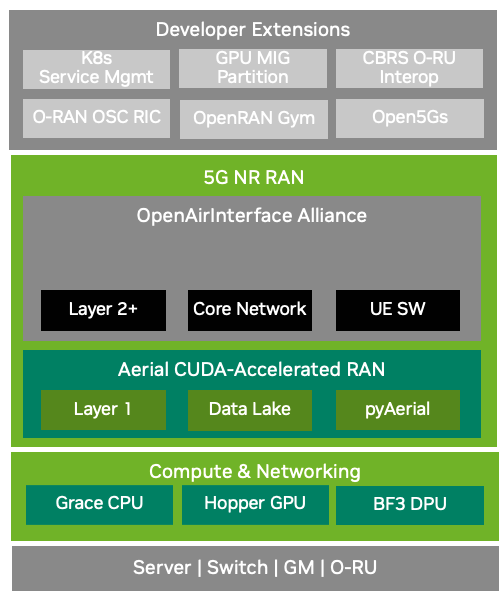
Compontent |
Feature |
|---|---|
COTS hardware |
COTS infrastructure composed of compute, virtualization, radios, fronthaul networking, precision timing, accelerators. |
Virtualization |
Virtualized RAN workloads from NVIDIA and Open Air Alliance |
AI/ML Frameworks |
Data Lake + pyAerial for AI/ML frameworks : RF / IQ data + FAPI |
Standards |
3GPP Release 15+ O-RAN 7.2 split P5G on-prem lab network |
Developer Tools |
Reference OAI CI leverage for developer integration workflow |
Developer Extension – Sterling |
NVIDIA NGC APIs for Sterling K8 service orchestration of network functions |
Developer Extension – OpenRAN Gym |
Developers can deploy AI/ML models for and on the radio access network using OSC radio intelligent controller by following Northeastern OpenRAN Gym tutorial. |
Developer Tools – Netowrk as a service |
NVIDIA SDK Manager development environment setup automation |
Note
Developer contributions through extensions and plugins - for community benefit and to accelerate pace of innovations welcome!
Multi-Vendor Integration#
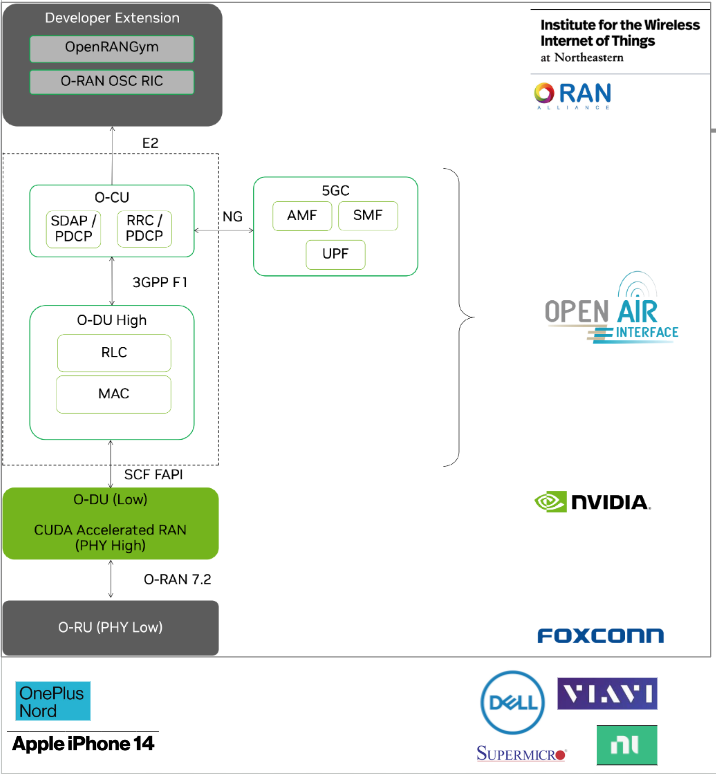
Leveraging O-RAN, and 3GPP specifications and interfaces enables multi-vendor interop towards the full stack building blocks and developer extensions and plugins. A multi-vendor reference blueprint is extended with the SCF FAPI interface between the O-DU low and O-DU high.
Organization |
Features |
|---|---|
Northeastern |
E2 interface plugin leveraging O-RAN OSC RIC and template xApps |
OpenAirAlliance |
O-DU-High (Layer 2), O-CU and 5GC |
NVIDIA |
O-DU Low / Phy High |
Foxconn |
O-RU Phy Low |
Others |
Handsets (Apple iPhone 14, Samsung S23), Viavi Qualsar Grandmaster, Dell FH switch, Supermicro server. |
Multi-Vendor Disaggregation#
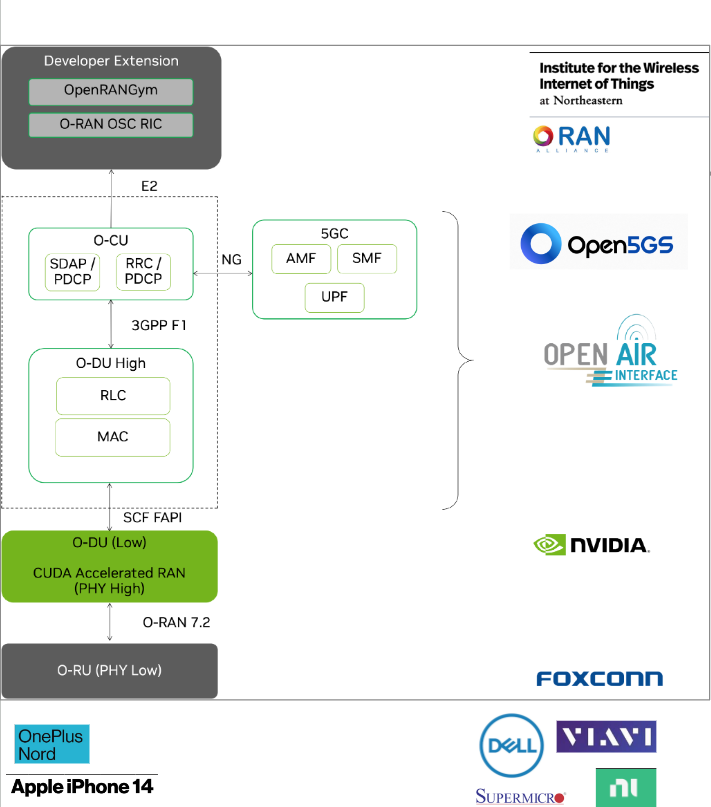
Leveraging O-RAN, and 3GPP specifications and interfaces enables multi-vendor interop towards the full stack building blocks and developer extensions and plugins. A multi-vendor reference blueprint is extended with the SCF FAPI interface between the O-DU low and O-DU high.
Organization |
Features |
|---|---|
Northeastern |
Developer extension with E2 interface plugin leveraging O-RAN OSC RIC and template xApps |
Plugin to leverage https://open5gs.org/ for 5GC instead of NVIDIA reference Open Air Interface 5GC. This highlights the use of modular, open, and interoperable components within disaggregated ORAN architecture |
|
OpenAirAlliance |
O-DU-High (Layer 2), O-CU and 5GC |
NVIDIA |
O-DU Low / Phy High |
Foxconn |
O-RU Phy Low |
Other |
Handsets (Apple iPhone 14, Samsung S23) |
Viavi Qualsar Grandmaster |
|
Dell FH switch |
|
Supermicro server |
On-Prem Data Center Deployment#
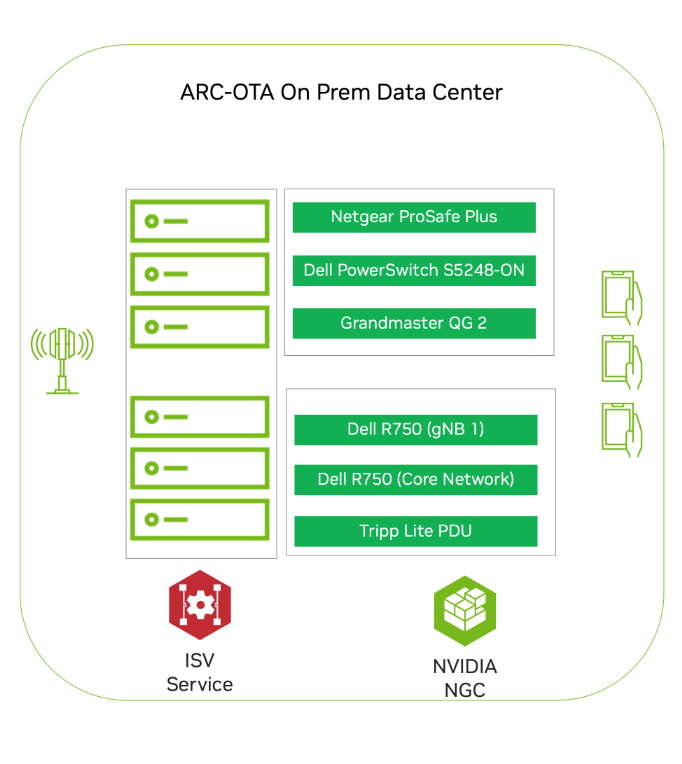
Component |
Feature |
|---|---|
Deployment |
Private data center can be housed and maintained by developers and researchers in their own facilities. |
Third-party ISV Managed Developer Service can be leveraged to procure, install, configure and monitor the on-prem data center. |
|
Virtualization |
On-prem infrastructure can be used to run a private cloud. |
ARC-OTA compute resources are virtualized for gNB and 5GC. |
K8 Service Management#
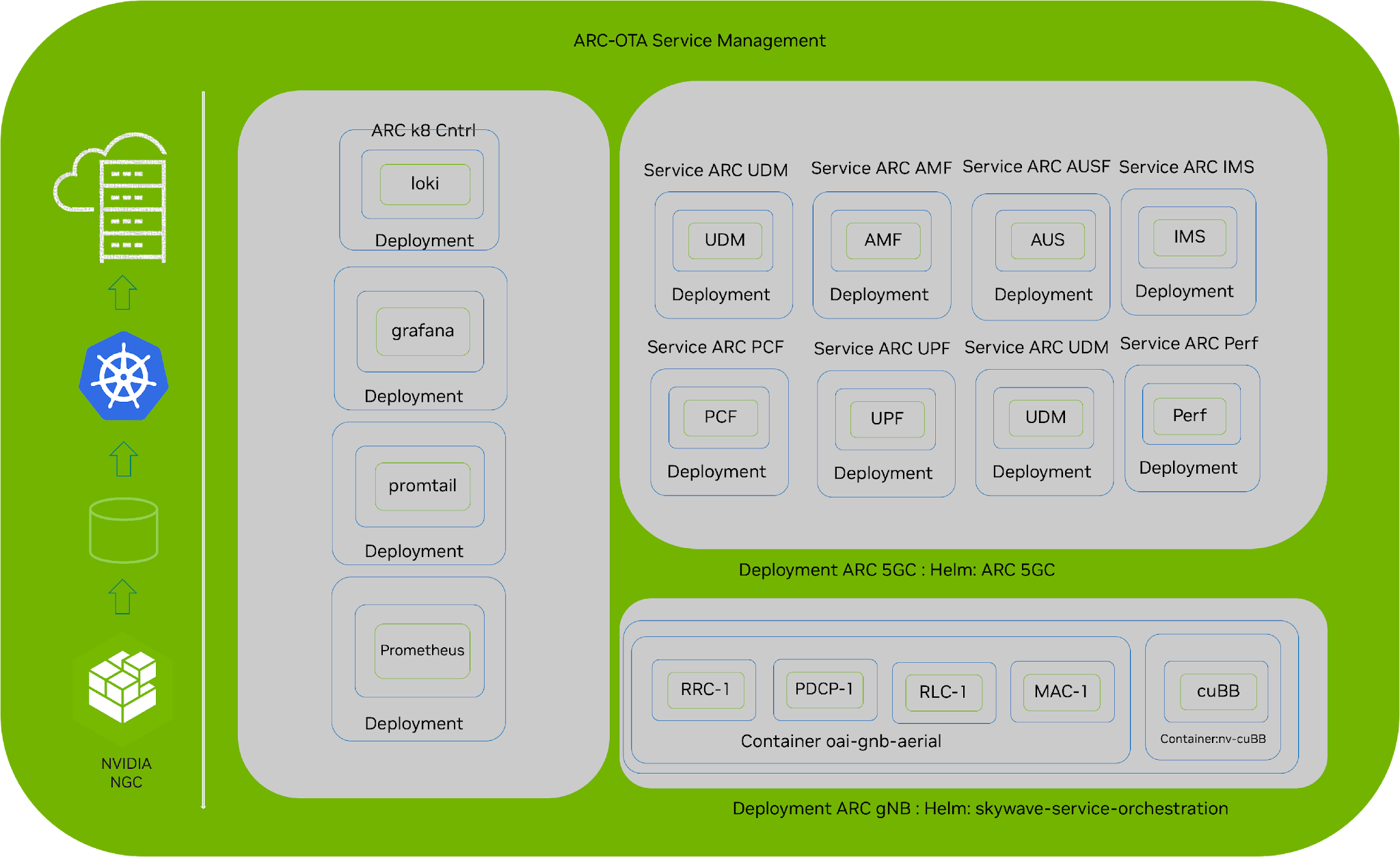
ARC-OTA provides Kubernetes for container orchestration. Both single node and multi-node deployment topologies are supported. ARC-OTA uses helm to manage applications.
Deployment |
Description |
|---|---|
ARC gNB |
The helm chart uses K8 deployment to create pod gNB. The gNB pod contains the containers nv-cubb and oai-gnb-aerial. Both containers are installed in the same pod to allow the use of shared memory between Layer 1 and Layer 2+. This helm chart is available for download from NGC. |
Deployment ARC 5GC |
The helm-chart is installed on the CN5G server or same physical server as the gNB. This helm chart creates multiple K8 deployments depicted on left. This helm chart is available for download from the OAI GitLab repository |
ARC-OTA Service Monitoring feature uses a combination of Grafana, Loki, Promtail and Prometheus. The feature was developed using open-source industry standard tools and it can be extended to specific developer needs
Reference the Sterling developer extension for additional details.
O-RAN 7.2 Split#
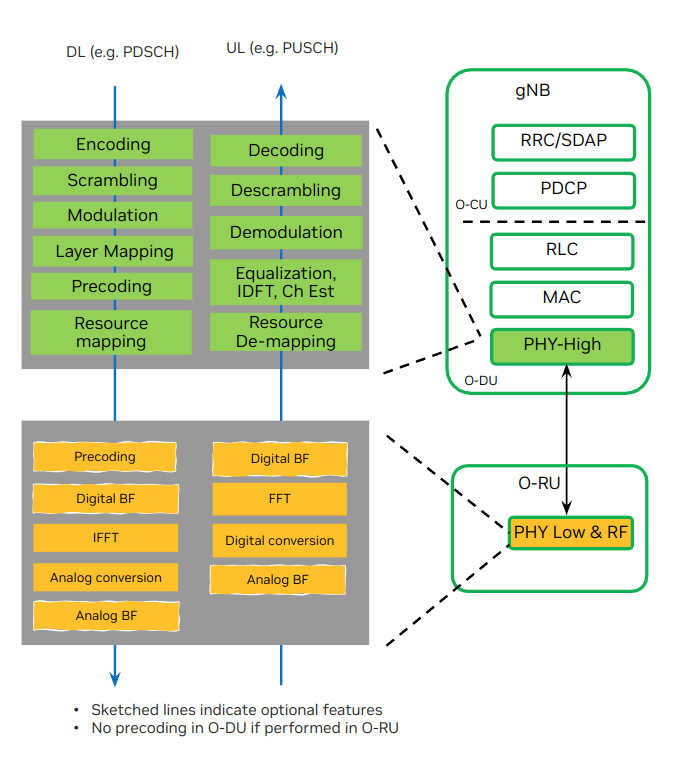
O-RAN’s split-RAN concept disaggregates the RAN into multiple functional components. These components can be deployed on different hardware and software platforms and can be interconnected using open interfaces.
ARC-OTA leverages the 7.2x split, which divides the protocol stack into the following:
Component |
Description |
|---|---|
O-RU (O-Radio Unit) |
The O-RU is responsible for the physical layer (PHY) processing, including RF signal processing and analog-to-digital conversion. |
O-DU (O-Distributed Unit) |
The O-DU is responsible for the higher-layer processing, including MAC, RLC, and PDCP |
Fronthaul interface |
O-RAN alliance specified fronthaul interface between the O-DU and O-RU based on the 7.2x split. This interface supports control, user, synchronization (CUS), and management(M) planes |
CSI Dataset#
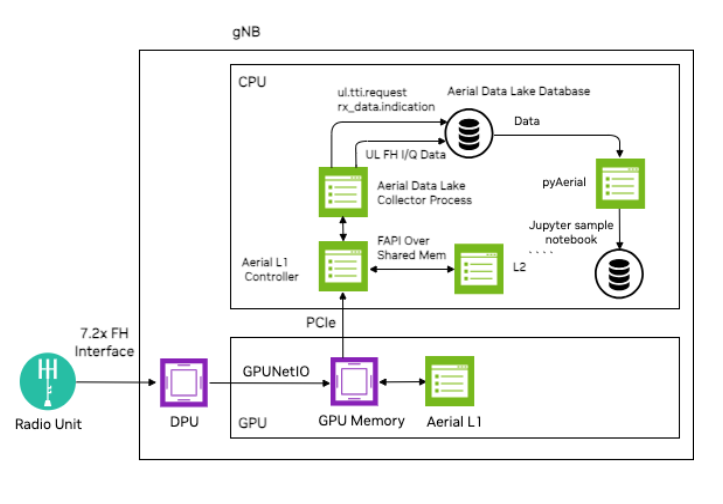
ARC-OTA integrated Aerial Data Lake provides the ability to capture OTA radio frequency (RF) data from the base station (BS). Raw IQ samples from the 7.2x split fronthaul (FH) interface are collected in a database file
Using the Aerial Data Lake database APIs, pyAerial can access RF samples in the database and transform these samples into training data or data sets for signal processing functions.
A sample Jupyter notebook has been provided that can create a sample multi-UE CSI dataset
SDKManager automation will help developers install AI/ML frameworks to easily generate a dataset
OpenRAN Gym#

Streaming of relevant key performance metrics (KPMs) and the enforcement of control actions to reflect decisions taken by the xApps on a Near-Real-Time (Near-RT) RAN Intelligent Controller (RIC) blueprint is shared through the OpenRAN Gym integration and an example monitoring xApp.
Potential xApps can be developed for network intelligence like handover optimization, policy enforcement, resource assurance or radio link management or resource control applications like load balancing or network slicing.
Northeastern has integrated the E2 interface with O-RAN OSC RIC and a template monitoring xApp using a custom E2 Agent to E2 Service Model. xApp Python bindings and xApp Connector collectively provide the RAN close loop monitor and control functions. This tooling helps developers incorporate network adaptability functions with AI/ML based xApps